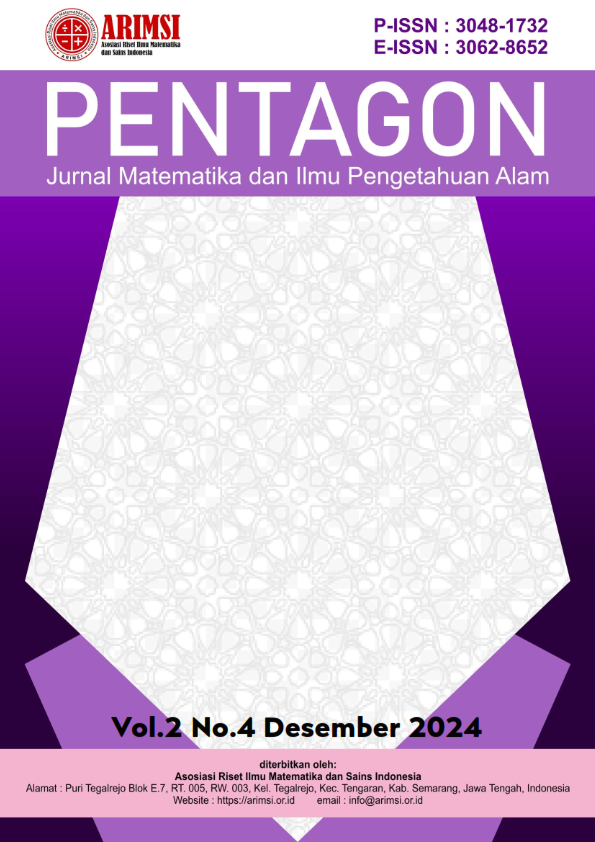Visualisasi Interaktif Permukaan dalam Ruang Tiga Dimensi: Analisis Geometris dengan GeoGebra
DOI:
https://doi.org/10.62383/pentagon.v2i4.317Keywords:
Three-dimensional surfaces, GeoGebra, visualization, normal vectors, curvatureAbstract
Surfaces in three-dimensional space can be represented through explicit, parametric and implicit equations, which describe the relationship between the variables x, y and z. Graphs of linear equations produce flat planes, while quadratic equations form objects such as spheres or ellipsoids. In this research, a theoretical approach is combined with interactive visualization to analyze various surface shapes. Through the use of GeoGebra software, this analysis makes it easier to understand surface orientation and shape, such as normal vectors and curvature, as well as applications in vector fields. This research also investigates the concepts of Cartesian coordinates in three-dimensional space, by depicting surfaces in the form of graphs of functions of two variables. It is hoped that the results of this research can provide deeper insight into the geometric properties of surfaces and how to visualize them effectively in mathematics and physics applications.
Downloads
References
Ahmad Azzam, Z., Erviantono, T., Wayan Radita Novi Puspitasari, N., & Penulis, K. (2024). Black Lives Matter: Gerakan sosial dan pengaruhnya terhadap kondisi politik Amerika Serikat. Jurnal Relasi Publik, 2(2), 1–09. https://doi.org/10.59581/jrp-widyakarya.v2i2.3029
Aliyah, R., & Fanirin, M. H. (2022). Analisis kesulitan belajar matematika pada siswa kelas VI Madrasah Ibtidaiyah Darurrohman Kertanegara Haurgeulis. SALAM: Jurnal Sosial Dan Budaya Syar-I, 9(6), 1783–1796. https://doi.org/10.15408/sjsbs.v9i6.28098
Anisah, N., Sartika, M., & Kurniawan, H. (2021). Penggunaan media sosial Instagram dalam meningkatkan literasi kesehatan pada mahasiswa. Jurnal Peurawi: Media Kajian Komunikasi Islam, 4(2), 94. https://doi.org/10.22373/jp.v4i2.11080
Brzezinski, T. (n.d.). Exploring cross section and surface of revolution intuitively. GeoGebra. Retrieved from https://www.geogebra.org/m/aavgbgnt
Budhi, W. S. (2015). Geometri di bidang Euclid. Repository.Ut.Ac.Id, 1–21. http://repository.ut.ac.id/4364/1/MPMT5201-M1.pdf
Chivai, C. H., Soares, A. A., & Catarino, P. (2024). Promotion of spatial visualization with GeoGebra and Qubism 3D software. Educ. Pesqui., 50, e275201. Retrieved from https://www.scielo.br
GeoGebra. (n.d.). 3D calculator - GeoGebra. Retrieved from https://www.geogebra.org/3d
Paradesa, R. (2016). Pengembangan bahan ajar geometri transformasi berdasarkan visual. Jurnal Pendidikan Matematika JPM RAFA, 2(1), 56–84.
Ponce Campuzano, J. C. (n.d.). Plotting 3D surfaces. GeoGebra. Retrieved from https://www.geogebra.org/m/jmTFk4eg
Putri, A. I., & Yahfizham. (2024). Analisis perbandingan algoritma pada TikTok dan Instagram sebagai content media dalam pemasaran. 3(1).
Putri, A. I., Meilinda, N., Rahmadsyah, F., & Zulham. (2024). Penerapan habits membaca sebagai rekontruksi historical peradaban Islam di era modern. 3(1).
Rahman, A. (2018). Strategi belajar mengajar matematika. In Buku.
Sari, P. (2019). Analisis strategi mahasiswa dalam menentukan turunan fungsi dengan metode diferensiasi logaritmik. Jurnal Riset Pendidikan Dan Inovasi Pembelajaran Matematika (JRPIPM), 2(1), 1. https://doi.org/10.26740/jrpipm.v2n1.p001-014
Soares, A. A., & Catarino, P. (2022). Application of GeoGebra in the teaching of descriptive geometry: Sections of solids. Mathematics, 10(17), 3034. https://doi.org/10.3390/math10173034. Retrieved from https://www.mdpi.com
Spaan, E., & van Naerssen, T. (2018). Migration decision-making and migration industry in the Indonesia–Malaysia corridor. Journal of Ethnic and Migration Studies, 44(4), 680–695. https://doi.org/10.1080/1369183X.2017.1315523
Tarihoran, D., Nau Ritonga, M., & Lubis, R. (2021). Teori belajar Robert Mills Gagne dan penerapan dalam pembelajaran matematika. JURNAL MathEdu (Mathematic Education Journal), 4(3), 32–38. https://doi.org/10.37081/mathedu.v4i3.2242
Downloads
Published
How to Cite
Issue
Section
License
Copyright (c) 2024 Pentagon : Jurnal Matematika dan Ilmu Pengetahuan Alam

This work is licensed under a Creative Commons Attribution-ShareAlike 4.0 International License.





